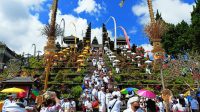- CREMATION ceremonies are held by Hindu community (chiefly in Bali) to cut down ties of astral body to its corporeal body and to pave the way to the afterlife realm
Ngaben is a death ceremony in the form of cremation or burning of corpses held by Hindus in Bali and can be classified into a Pitra Yadnya ceremony (a ceremony addressed to ancestors).
In line with the goal of Hinduism, which is to achieve moksha (union of atman or spirit with Brahman) or reach heaven, it is hoped that the Ngaben ceremony will help to achieve this. Another very determining factor to achieve it is the karma and devotion of the deceased himself.
Types of cremation
Sawa Wedana–a cremation ceremony involving the bodies that are still intact (without being buried in advance). This ceremony is usually held within 3-7 days after the person’s death. It is an exception for ceremonies with ultimate levels which can take up to a month to prepare.
Asti Wedana—a cremation ceremony involving a corpse that was once buried. This ceremony is accompanied by a ngagah or taking out ceremony, namely the ceremony of digging up the remains of the person’s bones. After that, it is resumed with the next procession.
Swasta— this cremation ceremony does not involve the corpse or the bones of the corpse. By and large, this is done for several reasons: the person died abroad or far away, the body was not found and so on. Consequently, the body is usually symbolized by painted sandalwood and filled with magical characters as the corporeal body of the person’s atma.
Warak Kruron— a ceremony dedicated to babies who experienced abortion or died in the womb.
Ngelangkir: a ceremony intended for dead babies whose navel has not yet been taken off within less than 42 days old, including the baby’s fetus is still in the form of blood or has not been fully formed in the womb.
Ngelungah—ceremony for the corpse of a fetus whish has been perfect or after reaching the age of 42 but has not lost teeth. The body is not cremated, but it is enough to be buried and then the ground is leveled followed with appropriate ceremony.
Facilities
In ordinary cremation ceremonies (sawa wedana and asti wedana), usually a bade tower (with 3 stories and so forth) will be equipped with stairs to upload (in the house) and download the corpse (at the cemetery). This Bade serves to transport the bodies from the funeral home to the cemetery. Then, a container or sarcophagus used for burning the corpse in the cemetery will be made of an ox (bull) papier mache and the like. This equipment is optional, meaning it can be made or not made.
Objectives
Conceptually, the Ngaben or cremation ceremony itself aims and has the following meanings:
- Burning the corpse and then washing the ashes into the river or sea that means releasing the Atma (spirit) from worldly shackles. Hopefully, the spirit of the deceased will unite with God.
- As a series of ceremonies to return all the elements of the Panca Maha Bhuta (the five elements that make up the gross human body) to their respective origins so as not to hinder the journey of the spirit to its afterlife realm.
- For the family, this ceremony is symbolic that the family has been sincere, and has given up the person concerned.
If budget permits, cremation may be held individually at local cemetery or cemetery of each customary village. Related to facilities in use, there are series of equipment like bade tower, ox papier mache (sarcophagus) and this kind of cremation will surely involve more people. For sure, the customary villagers will help organize this ceremony. However, if the family wishes a simpler procession and involve less people due to particular reasons, this ceremony can be organized at crematorium.
Meanwhile, if considering far cheaper budget and togetherness, there is an alternative by holding cremation en masse. Almost all customary villages in Bali today have this program organized periodically every three or five years.










